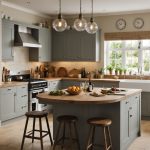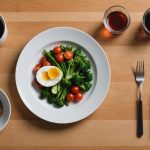Principles of Sustainable Kitchen Design
Sustainable kitchen design is gaining popularity for its focus on eco-friendly materials and energy efficiency. By integrating energy-efficient appliances, kitchens can significantly reduce their energy use, leading to both cost savings and a smaller carbon footprint. Choosing appliances with high energy ratings ensures minimal energy consumption without sacrificing performance. Furthermore, opting for eco-friendly materials—such as countertops made from recycled glass or cabinetry crafted from sustainably harvested wood—helps reduce the negative environmental impact.
One of the core principles involves selecting renewable resources that minimise resource depletion. For instance, bamboo, a rapidly renewable material, is an excellent choice for flooring or cabinetry. Non-toxic finishes play a crucial role in maintaining health and safety, offering long-term durability without emitting harmful chemicals.
Also read : Key Features of a Whisper-Quiet Dishwasher Perfect for Open Concept Kitchens
Energy efficiency extends beyond appliances to include water usage. Incorporating water-saving devices, like low-flow taps and efficient dishwashers, conserves water while maintaining kitchen functionality. Ultimately, these thoughtful choices in sustainable kitchen design significantly contribute to a healthier home environment and a more sustainable planet.
Selecting Eco-Friendly Materials and Finishes
Choosing sustainable materials and finishes is a fundamental aspect of sustainable kitchen design. These materials not only enhance the aesthetic value of a kitchen but also ensure a reduced environmental impact. Renewable resources like bamboo are excellent choices for cabinetry and flooring, as they grow rapidly and replenish quicker than traditional hardwoods.
Also to discover : Discover Ultimate Kitchen Health: An All-Inclusive Guide to Effortlessly Installing Your Water Filtration System
When considering countertops, options such as recycled glass, reclaimed wood, and concrete are both environmentally conscious and stylish. Not only do these materials reduce waste, but they also provide a unique look that can be customised to fit any design aesthetic.
The importance of non-toxic finishes in the kitchen cannot be overstated. Finishes that emit low or zero volatile organic compounds (VOCs) promote a healthier indoor atmosphere by improving air quality and minimising exposure to harmful chemicals. Opting for such finishes not only helps the environment but also supports the well-being of those using the kitchen.
Incorporating these eco-friendly options into your kitchen design ensures a balance between aesthetics and sustainability, fulfilling the dual role of creating a beautiful and environmentally responsible space.
Optimizing Kitchen Layout for Farm-to-Table Cooking
Designing a kitchen layout that enhances farm-to-table cooking is crucial for improving cooking efficiency and accessibility to fresh produce. To start, workflow efficiency is vital. Layouts should support smooth transitions between preparing, cooking, and cleaning areas, minimising unnecessary movements. What layout best aids this process? U-shaped kitchens often enhance workflow, while L-shaped ones cater to smaller spaces.
Maximizing Workflow Efficiency
An easy-flow environment can be supported by placing appliances like the fridge, sink, and stove in a practical triangle. This setup reduces steps between tasks, making meal preparation faster.
Designing Zones for Different Tasks
Dedicated zones for food preparation, cooking, and storage ensure that each area remains organised and clutter-free. For example, what is an ideal prep zone configuration? A section adjacent to the stove and sink, equipped with cutting boards and utensils, optimises efficiency.
Considerations for Indoor-Outdoor Flow
Integrating an outdoor space for homegrown produce access brings multiple benefits. How does one achieve this integration? Installing large windows or sliding doors enhances natural light and ensures easy access to a garden, blending the indoors with nature effortlessly. By approaching these aspects strategically, kitchens transform into a hub for fresh, healthy cooking.
Energy-Efficient Appliances for Sustainable Living
Selecting energy-efficient appliances is pivotal for sustainable kitchen design. How can one ensure the appliances contribute positively? The solution lies in choosing those with high appliance ratings. Appliances with superior energy efficiency ratings guarantee minimal electricity use while maintaining optimal performance. Additionally, integrating these into your kitchen setup reduces utility bills, offering long-term economic benefits.
Choosing Appliances with High Energy Ratings
High energy ratings indicate that an appliance consumes less power for the same output, thus being eco-friendly. For instance, energy-efficient refrigerators or ovens use advanced technology to maintain performance without excess consumption. This means that by opting for appliances with such ratings, you are supporting an energy-efficient household.
Importance of Water Efficiency
Using water-saving devices, like low-flow faucets and eco-friendly dishwashers, is vital. These devices help minimise water wastage significantly. Efficient water use in appliances ensures sustainability without compromising on functionality, making it a critical element of an environmentally responsible kitchen.
Fossil Fuel vs Electric Cooking Options
Deciding between fossil fuel and electric cooking options depends on sustainability goals. Electric stoves, especially induction types, offer superior energy efficiency compared to fossil fuel ones. This choice not only reduces greenhouse gas emissions but also aligns with eco-friendly living standards.
Nutritional and Functional Considerations for Raw Food Preparedness
Incorporating a raw food kitchen requires careful consideration of nutritional aspects and preparation functionality. Nutritional aspects play a vital role in ensuring a balanced diet. Raw foods often retain more nutrients, promoting better health when balanced properly. Key components include ample fruits, vegetables, nuts, and seeds, which provide essential vitamins and minerals not always found in processed foods.
Creating a kitchen with the right prep functionality is essential for efficiently preparing raw meals. Essential tools include high-quality blenders, food processors, and dehydrators. These tools help maintain flavour and nutrition in raw ingredients, allowing for a wider variety of meals. Placement of these tools should prioritise accessibility to enhance ease-of-use and workflow.
A thoughtful layout further improves the raw food kitchen experience. Incorporating cutting spaces near appliances and seasoning stations can streamline food preparation. Accessibility to fresh ingredients, either from a nearby refrigerator or a home garden, supports daily cooking activities. Emphasising both nutritional aspects and functional setup ensures an efficient and enjoyable raw food kitchen experience.
Real-Life Examples of Sustainable Kitchens
Exploring case studies of sustainable kitchens provides valuable insights and inspiration for those looking to implement eco-friendly changes in their own spaces. These examples showcase the creativity and adaptability of sustainable design in various settings.
One inspirational kitchen design is a bright, open-plan space that prioritises natural light and ventilation. Large windows and skylights reduce the need for artificial lighting, aligning with sustainable principles. Additionally, upcycled materials, such as reclaimed wood for countertops and shelving, add character while minimising waste.
In another example, an urban kitchen incorporates an innovative nature-inspired decor, blending indoor and outdoor elements seamlessly. Vertical gardens bring greenery into the kitchen, enhancing air quality and providing fresh herbs for cooking.
These projects highlight several key design solutions, including efficient layout planning and the selection of sustainable materials. The success of these kitchens underscores the importance of thoughtful design and resource management in creating aesthetically pleasing and environmentally responsible spaces. Ultimately, they offer lessons in balancing functionality and sustainability, guiding future efforts to build greener kitchens.
Principles of Sustainable Kitchen Design
Sustainable kitchen design focuses on integrating eco-friendly materials and enhancing energy efficiency. Selecting sustainable materials such as recycled glass countertops or cabinets crafted from sustainably harvested wood minimizes environmental impact. These materials not only support sustainability but also contribute to an aesthetically pleasing kitchen environment.
Beyond aesthetics, incorporating energy-efficient appliances significantly reduces energy consumption. For instance, appliances with high energy ratings ensure minimal electricity use without compromising performance. This reduction in energy demand not only cuts costs but also decreases the kitchen’s carbon footprint.
Importance of Eco-Friendly Materials
Using eco-friendly materials is crucial in sustainable kitchen design. They help reduce waste and promote environmental conservation. Bamboo and reclaimed wood are excellent choices due to their rapid renewability and unique textures, offering both practicality and style.
Benefits of Energy Efficiency
Energy efficiency extends beyond appliances to include efficient water usage. Integrating water-saving devices, like low-flow taps and dishwashers, conserves water without sacrificing functionality. By making these intentional choices, kitchen designs become a cornerstone of sustainable living, championing both environmental and economic benefits.
Expert Recommendations and Resources
In the realm of sustainable kitchen design, expert advice plays a crucial role in guiding eco-conscious homeowners. Sustainability resources offer valuable insights and suggestions for creating environmentally-friendly spaces.
Interviews with Sustainable Design Experts
Engaging with industry professionals provides practical knowledge and inspiration. Experts often highlight the importance of integrating both aesthetics and functionality in sustainable designs. They also address common challenges and misconceptions, ensuring that homeowners make informed decisions.
Recommended Books and Online Resources
A wealth of literature and digital content focuses on sustainability resources for kitchen design. Books offer in-depth analysis on materials, design principles, and case studies. Meanwhile, online platforms provide up-to-date information, trends, and multimedia tutorials, making them excellent tools for learning.
Workshops and Courses for Eco-Friendly Design
Participating in workshops and courses offers hands-on experiences and direct interaction with experts. These educational opportunities help individuals understand sustainable materials, technology advancements, and the effectiveness of various green strategies. By joining these initiatives, one gains a supportive community dedicated to achieving eco-friendly living spaces.





